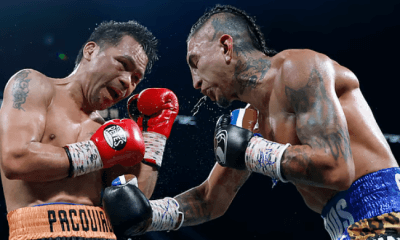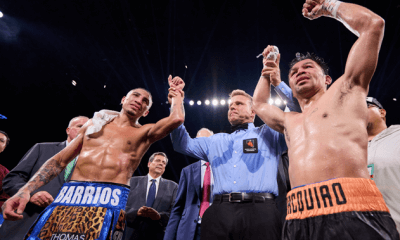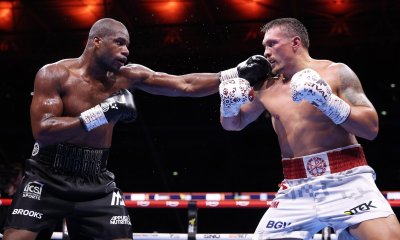Articles of 2009
Fighters Are Much More Vulnerable To Ill-Fated Comebacks
In a perfect sporting world, every athlete would leave while they were still capable of fighting and would not find themselves retired, but still yearning to compete, to re-enter the arena and test themselves. However, it's rare today for a great — I mean a genuine all-time great like John Elway, Sandy Koufax, Jim Brown, Rocky Marciano or Lennox Lewis — to leave at the perfect time and never come back. Often great fighters and athletes are driven back because what they did on the field of play is what gave them their identity, or they unfortunately need money.
I have no doubt the athletes who retire and never come back miss the limelight, adulation, money, and being the center of attention as much as their peers who for whatever reason tempt fate and come back. I also believe those who stay retired and never try to come back developed other interests during their careers, something most likely those who can't give up their past life probably didn't. Having something else to occupy their time and thoughts has to help.
In professional boxing it's much easier for a former great to try to get back into the mix than it is for retired athletes in other professional sports because of boxing’s lack of regulation and guidelines. There are more than a couple of things the fighter is a victim of due to the construction of his sport and his own success. Usually when a great fighter comes back after retiring, we really never saw him beaten decisively or taken apart. When Joe Louis came back and ultimately got knocked out of the ring by Rocky Marciano, he looked sad and helpless. Compare that to Johnny Unitas or Joe Montana throwing a few interceptions at the end of their careers because they now were throwing with a rag-arm.
Muhammad Ali and Michael Jordan are without question the most well known athletes living. In reality, Ali and Jordan are probably two of the most recognized people who have yet lived. They also share coming back after being retired at age 39 (Ali was three months shy of turning 39) to take on the heir apparent. Jordan was totally outplayed by Kobe Bryant during the last season he played, overall and in face-to-face competition.
Ali's Kobe Bryant was named Larry Holmes. For ten rounds or 30 minutes on Oct. 2, 1980, Ali was pummeled by Holmes before his trainer Angelo Dundee stopped the fight after the tenth round. Because Ali participated in a man vs. man combat sport, he looked much worse. Jordan, like Ali, didn't win a statistical category going against Bryant, but didn't look nearly as bad.
The same applies to an old quarterback having his pass returned for a touchdown or an old two-guard shooting 4/26 and turning the ball over seven times. The vision of the fighter losing in such a convincing fashion is seared into our minds a lot more than any bad pass or missed shot. That's because the shortcomings of Montana and Jordan are only highlighted for a few seconds at a time, instead of an uninterrupted half hour.
Something else going against the great fighters trying to come back is we usually don't see them bettered until their skills have eroded as they've aged. Seeing great fighters fail so miserably when they come back is a shock and hard to fathom, especially since we've never seen it happen to them before.
Great fighters can't fail during their prime. If they did they certainly wouldn't be thought of as greats. Michael Jordan missed plenty of shots in his prime, he just missed more when he was 38. Tom Seaver gave up home runs when he was Tom Terrific, just not as many as he did at the end of his career. Joe Montana threw his share of interceptions and incompletions during his peak years, but not as many as he did during the last couple years he played.
Fighters are also much more vulnerable to comeback failings as opposed to past greats in other sports because of the differing structure of boxing and other sports. When fighters contemplate returning to the ring they know they won't be measured by a stopwatch, radar gun or have to compete with a first-round draft pick. If Tom Seaver used to throw at 95 mph and is now only throwing at 89-90, the team will save him from himself and not sign him, or they'll release him. If Joe Montana doesn't have the same release and accuracy that he once had, he'll end up playing for the Chiefs and struggling, especially if Steve Young is riding the bench for a lot of money.
In boxing, fighters only need to pass a physical and get their weight down to get a boxing license for $25.00. If you're talking about an all-time great, you better believe that the sparring partners who work with them during training will not try to make a name off him, at least not more than once. If Holmes was handling his sparring partners while preparing for Jesse Ferguson in 1994, he feels like he's close to the same fighter who prepared for Shavers and Cooney circa 1979-82. That's the problem with boxing: Sparring sessions and workouts can be manipulated and controlled, unlike radar guns and stopwatches.
The problem with older athletes is no different from what it is with every aging man or woman. It just hurts fighters more than other athletes and the rest of society. I feel like the same person I did twenty years ago and see myself the same in front of the mirror as I did then. I haven't lost my hair and haven't gained much weight. But I certainly can't pass for 29, either.
As a member of IBRO (International Boxing Research Organization), during the years 2005-2006 we ranked the 20 greatest fighters in the original eight weight divisions. It was obvious based on how the ratings shook out that the members didn't hold Joe Louis's embarrassing defeat against Marciano against him or Sugar Ray Robinson's loss to Joey Archer against him.
It wouldn't be so terrible if when fighters made ill fated comebacks that they'd only end up looking as bad as Jordan or Montana when it's over, but we know better. The only thing that can be counted on is fighters usually can't be saved from themselves. Sadly, the spotlight will still be very bright on the night his stardom has dimmed the most.
Frank Lotierzo can be contacted at GlovedFist@Gmail.com
-

 Featured Articles3 weeks ago
Featured Articles3 weeks agoThe Hauser Report: Zayas-Garcia, Pacquiao, Usyk, and the NYSAC
-

 Featured Articles2 weeks ago
Featured Articles2 weeks agoOscar Duarte and Regis Prograis Prevail on an Action-Packed Fight Card in Chicago
-

 Featured Articles1 week ago
Featured Articles1 week agoThe Hauser Report: Cinematic and Literary Notes
-

 Book Review4 days ago
Book Review4 days agoMark Kriegel’s New Book About Mike Tyson is a Must-Read
-

 Featured Articles4 weeks ago
Featured Articles4 weeks agoManny Pacquiao and Mario Barrios Fight to a Draw; Fundora stops Tim Tszyu
-

 Featured Articles4 weeks ago
Featured Articles4 weeks agoArne’s Almanac: Pacquiao-Barrios Redux
-

 Featured Articles3 weeks ago
Featured Articles3 weeks agoRemembering Dwight Muhammad Qawi (1953-2025) and his Triumphant Return to Prison
-

 Featured Articles4 weeks ago
Featured Articles4 weeks agoOleksandr Usyk Continues to Amaze; KOs Daniel Dubois in 5 One-Sided Rounds













